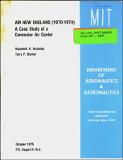| dc.contributor.author | Ausrotas, Raymond A. | en_US |
| dc.contributor.author | Blumer, Terry P. | en_US |
| dc.contributor.other | Massachusetts Institute of Technology. Flight Transportation Laboratory | en_US |
| dc.date.accessioned | 2012-01-06T06:40:32Z | |
| dc.date.available | 2012-01-06T06:40:32Z | |
| dc.date.issued | 1975 | en_US |
| dc.identifier | 02396967 | en_US |
| dc.identifier.uri | http://hdl.handle.net/1721.1/67925 | |
| dc.description | October 1975 | en_US |
| dc.description | On cover, series statement "R75-9" is the correct numbering; t.p. has "75-7" and has been corrected to "75-9" by hand | en_US |
| dc.description | Includes bibliographical references | en_US |
| dc.description.abstract | This is a brief account of research by CAB staff. The success of Air New England from the beginning of its corporate life to the summer of 1974, when it was offered a certificate of public convenience and necessity by the CAB, can be attributed to a number of factors. The foremost was capable management. The management team at Air New England had previous experience operating commuter airlines in the New England area and was aware of the two major pitfalls that would undermine profitability, excess capacity and high corporate overhead, and was careful to avoid them. Further, the regulatory environment in which the commuters operated was such as to allow various competitive marketing strategies to be tried by management, such as modifying fare structures, flying different routings, and changing frequencies on routes. Additionally, the area chosen for initial market penetration, the Cape and Islands, was dense enough to support a number of airlines during the peak season, and allowed Air New England to minimize its start-up losses. Air New England's management was, of course, aware of the financial situation at Executive, its major established competitor. Air New England realized that if it was able to control its own costs, the financial difficulties that had existed at Executive during previous years would eventually lead to the disappearance of that particular competitor. (Of course, the possibility always existed that new commuters could also appear.) Thus, the emergence of Air New England as the dominant commuter air carrier in New England was a combination of management skills in all areas of airline operations combined with mismanagement on the part of their competitors. In the summer of 1974 Air New England's future was bright. | en_US |
| dc.description.sponsorship | Sponsored by the Department of Transportation. | en_US |
| dc.format.extent | 62 p | en_US |
| dc.publisher | Cambridge, Mass. : Flight Transportation Laboratory, Massachusetts Institute of Technology, [1975] | en_US |
| dc.relation.ispartofseries | FTL report (Massachusetts Institute of Technology. Flight Transportation Laboratory) ; R75-9 | en_US |
| dc.subject | Local service airlines | en_US |
| dc.subject | New England | en_US |
| dc.title | Air New England (1970-1974) : a case study of a commuter air carrier | en_US |
| dc.type | Technical Report | en_US |
